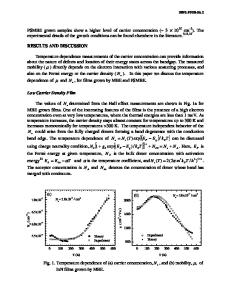Thin films of rf-magnetron sputtered InN on mica: Crystallography, electrical transport, and morphology
- PDF / 936,036 Bytes
- 8 Pages / 576 x 792 pts Page_size
- 68 Downloads / 332 Views
Reactive rf-magnetron sputtering has been employed for the growth of thin films of InN on the (001) face of mica at a variety of substrate temperatures from 50 to 550 °C. These films have been characterized by x-ray scattering, stylus profilometry, and electrical transport measurements, and their topography has been studied by SEM and STM. At low deposition temperatures, the InN films exhibit texture [(00.1) I n N || (001) m i c J, while at higher deposition temperatures a large fraction of the grains are heteroepitaxial [ (00-1) I n N 11 (001) m i c a , (21.0) InN_ 11 (060) m i c J . The utility of the x-ray precession method in the determination of this heteroepitaxial relationship is highlighted. The films exhibit a local mobility maximum near a substrate temperature of 350 °C, beyond which a sharp increase in resistivity associated with voids and cracks owing to the onset of secondary grain growth leads to a dramatic decrease in electrical mobility. At the highest growth temperatures, however, the interconnection between grains improves and lower resistivity and higher mobility are re-established.
I. INTRODUCTION There have been several studies of the effect of substrate on the structural properties, morphology, electrical transport, and device applications for thin films of the Group IIIA metal nitrides. Clearly, however, deposition onto sapphire [both the C(00.1) and the R(01.2) planes] has dominated early1 and later2 studies on films of A1N, GaN, and InN prepared by a variety of synthetic techniques. There have, nevertheless, been a number of attempts to grow thin films of the Group IIIA nitrides on substrates other than sapphire. Two of the most interesting cases have been (a) deposition onto (00.1) 6H-SiC, 3 including studies on the effect of growth on the two polar planes (either Si or C terminated) of the 6H polymorph and the stabilization of the cubic phase of GaN via growth on the (111) face of /3-SiC 4 ; and (b) growth on the (111) plane of the cubic semiconductors Si5 and GaAs.6 The 6 H - and /3-polymorphs of SiC have the best in-plane lattice matches with GaN and are considered among the most promising substrates for hightemperature electronic applications, such as blue lightemitting diodes.3'4 Deposition onto (111) Si and GaAs holds considerable promise for the marriage of two semiconducting families and the realization, for example, of efficient, high-speed M-I(AlN)-S(Si or GaAs) optoelectronic devices.5-6 In comparison to these innovations in the deposition of single-crystalline films of GaN and A1N on the polymorphs of SiC, the exploitation of suitable substrates for the growth of single-crystal thin films of InN re1300
http://journals.cambridge.org
J. Mater. Res., Vol. 6, No. 6, Jun 1991
Downloaded: 14 Mar 2015
mains a very active research effort. Recently, we have identified the pseudo-hexagonal (001) face of monoclinic muscovite mica7 as a candidate for deposition of thin films of the Group IIIA nitrides. The lattice mismatch for A1N (3.7%) is particularly encouraging, and that for GaN (
Data Loading...











